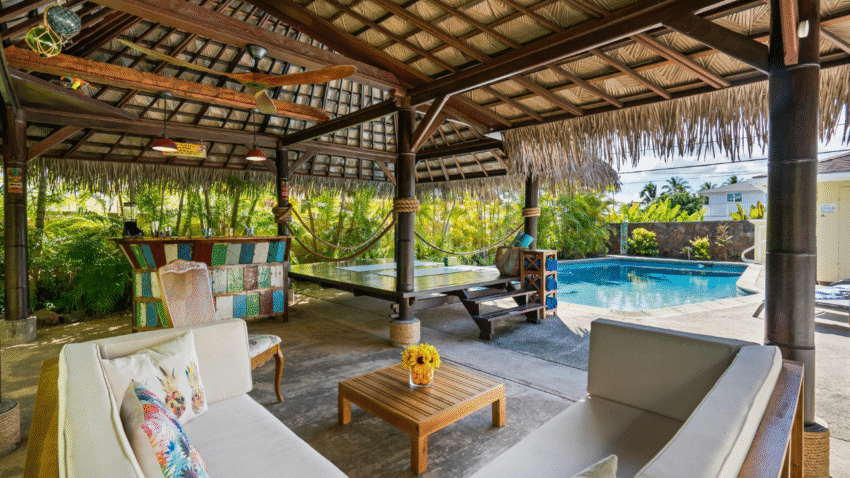Introduction
Patio design doesn’t have to follow a single theme or rigid style. In fact, some of the most inviting and stylish patios are created by mixing furniture styles. Learning how to mix furniture styles for patio design allows you to blend modern, rustic, vintage, or eclectic pieces into a harmonious outdoor space that reflects your personality. If you’ve ever worried that your patio looks mismatched or uninspired, this guide will show you how to combine styles confidently and effectively.
Why Mixing Styles Works for Patios
Blending furniture styles adds character and flexibility to your outdoor space. Instead of being limited to one look, you can:
- Show personality: A mix of pieces tells a story and feels authentic.
- Reuse and repurpose: Incorporate furniture you already own with new finds.
- Save money: Thrifted, inherited, or DIY items fit right alongside modern purchases.
- Create balance: Mixing textures, colors, and shapes makes your patio visually interesting.
The key is intentional design—mixing styles without letting the space feel chaotic.
Step-by-Step Guide to Mixing Furniture Styles for Patio Design
1. Choose a Dominant Style
Start with one main style as the foundation of your patio. This creates cohesion and prevents the space from looking disorganized. Examples include:
- Modern: Clean lines, sleek metal or composite furniture.
- Rustic: Wooden benches, distressed finishes, and earthy tones.
- Bohemian: Colorful textiles, eclectic seating, and global-inspired accents.
- Coastal: Light wicker furniture, blues, whites, and driftwood textures.
Once you have a dominant style, you can layer other styles in smaller doses.
2. Mix by Material
Combining materials is one of the easiest ways to mix furniture styles:
- Pair metal chairs with a wooden table for contrast.
- Add woven wicker pieces alongside modern glass tables.
- Combine stone side tables with upholstered benches.
Using a variety of materials adds richness without overwhelming the design.
3. Use Color to Tie Styles Together
Color creates harmony between different furniture types:
- Choose a consistent color palette (two main colors, one accent).
- Paint mismatched pieces in the same shade for unity.
- Use cushions, pillows, or throws in coordinating colors to connect contrasting furniture.
For example, a rustic wooden bench and modern metal chairs feel connected if both feature cushions in the same vibrant blue.
4. Balance Shapes and Proportions
Mixing styles works best when the overall proportions feel balanced:
- Combine straight-lined modern sofas with rounded wicker chairs for softness.
- Pair a heavy wooden table with lighter, more open-frame chairs.
- Avoid overcrowding—leave space for flow and comfort.
Balancing shapes ensures that different styles complement rather than clash.
5. Add a Unifying Rug
An outdoor rug is a simple trick to anchor mixed-style furniture. Rugs pull together varied seating and tables, making them feel like one intentional set.
- Bold patterns can unify eclectic or bohemian designs.
- Neutral rugs ground rustic or coastal patios.
- Bright solids connect modern and vintage combinations.
6. Blend Old and New Pieces
Mixing vintage and contemporary pieces creates timeless charm:
- Use a vintage coffee table with sleek, modern chairs.
- Pair a new sectional with retro side tables.
- Refinish older wooden pieces to sit alongside polished, modern designs.
The contrast creates interest while preventing the patio from looking too uniform.
7. Layer Textures for Depth
Texture adds dimension and helps unify mixed styles:
- Wicker and rattan soften metal furniture.
- Smooth glass balances rough wood.
- Textiles (pillows, blankets, rugs) connect diverse furniture through softness.
For example, a rustic wooden chair paired with a metal bistro set feels cohesive when both share patterned cushions.
8. Add Accent Pieces Strategically
Accent items help tie everything together:
- Use matching side tables to link different seating types.
- Add lanterns, planters, or trays in coordinating styles.
- Hang string lights or outdoor curtains to soften and unify the patio.
Accent pieces bridge gaps between furniture styles and create flow.
9. Create Functional Zones
If your patio is large, define different zones with different styles:
- Dining area with rustic wood furniture.
- Lounge area with modern sectional and eclectic accents.
- Reading nook with vintage chairs and a small side table.
Zones allow variety without overwhelming a single space.
10. Trust Your Personal Taste
The most successful patio designs reflect the personality of those who use them. If you love a mix of rustic and modern or bohemian and coastal, trust your instincts. Use design guidelines for balance, but let your taste lead the way.
Common Mistakes to Avoid
- Mistake: Mixing too many styles.
Solution: Stick to two or three complementary styles, not every type at once. - Mistake: Ignoring color harmony.
Solution: Always use a consistent color palette to connect furniture pieces. - Mistake: Overcrowding the patio.
Solution: Leave open space to maintain comfort and flow. - Mistake: Forgetting scale.
Solution: Balance heavy, bulky furniture with lighter, airier pieces. - Mistake: Treating indoors and outdoors the same.
Solution: Choose durable, weather-resistant materials to keep your patio long-lasting.
Extra Patio & Deck Tips & Hacks
- DIY Touches: Repaint or re-stain mismatched pieces to make them blend.
- Eco-Friendly Mix: Combine recycled furniture with modern purchases for budget and sustainability.
- Seasonal Switches: Swap out textiles each season to refresh your mixed-style patio.
- Related Guide: For low-cost design ideas, check out our article on How to Decorate a Patio on a Budget.
Conclusion
Mixing furniture styles for patio design gives you the freedom to create a space that’s both unique and personal. By choosing a dominant style, balancing shapes and colors, and unifying with rugs, textiles, and accents, you can blend rustic with modern, vintage with bohemian, or any other mix that inspires you.
A thoughtfully mixed patio feels stylish, inviting, and authentically yours—proving that the best designs don’t follow rules, they reflect personality.
